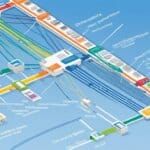Table of Contents
Welcome to our informative article on the OSI physical layer. In this section, we will delve into the fundamental aspects of the physical layer in the OSI model, exploring its basic purpose and functions. As you continue reading, you will gain insight into how the physical layer serves as the backbone of network communication, ensuring the smooth transmission of data. Let’s dive in.
The physical layer, being the first and lowest layer in the OSI model, plays a vital role in the transmission of data across various interfaces. It acts as the foundation upon which the other layers are built, determining how bits are converted into predictable signals for transmission. The primary function of the physical layer is to define bits, establish data rates, ensure synchronization, determine transmission modes, provide interfaces for device connectivity, configure point-to-point or multipoint connections, and facilitate switching mechanisms and signal equalization.
Moreover, the physical layer also plays a significant role in establishing physical topologies, supporting various protocols such as Ethernet, Bluetooth, and USB, which are essential for seamless network communication. It sets up the groundwork for communication over a network by defining the electrical, mechanical, and procedural aspects of transmitting raw data between devices. The physical layer ensures that bits are accurately represented into predictable signals, whether through electrical, optical, or radio waves.
Stay tuned as we explore further sections on the physical layer, including its functions, different modes of transmission medium, physical topologies, protocols, and the pros and cons of the OSI model. Read on to broaden your understanding of the crucial role played by the physical layer in network communication.
What is the Physical Layer in the OSI Model?
The physical layer is a fundamental component of the OSI model, serving as the first layer in the network protocol stack. It plays a crucial role in enabling communication over a network, facilitating the physical transmission of data bits between network devices.
In essence, the physical layer is responsible for the transfer of raw data over a communication channel. It defines the electrical, mechanical, and procedural aspects of data transmission, ensuring that bits are transformed into predictable signals that can be transmitted through various mediums such as electrical wires, optical fibers, or radio waves.
The physical layer defines how devices are physically connected to the network, establishing the foundation for the higher layers. It determines the physical characteristics of these connections, including the cables, connectors, and interfaces used. By providing this connectivity, the physical layer enables communication between devices and allows data to flow seamlessly across the network.
Furthermore, the physical layer ensures that data bits are transmitted reliably and accurately from the sender to the receiver. It encompasses the encoding and decoding of bits into appropriate signals, as well as mechanisms for error detection and correction.
In summary, the physical layer in the OSI model is responsible for the physical transmission of data over a network. It sets up the foundation for communication, defines the physical connections, and ensures the reliable transfer of data between devices. Without the physical layer, communication over a network would not be possible.
Functions of the Physical Layer
The physical layer of the OSI model serves several crucial functions that are essential for the smooth operation of a network. Understanding these functions is crucial to grasp the role and responsibilities of the physical layer. Let’s explore the key functions performed by the physical layer:
- Defining Bits: The physical layer defines the basic unit of data, known as bits, which are represented as binary digits 0 and 1. This ensures that data is transmitted in a standardized format across the network.
- Determining Data Rate: The physical layer determines the rate at which data is transmitted over the network. This includes establishing the speed and bandwidth required for the data transfer.
- Ensuring Synchronization: Synchronization is crucial for accurate data transmission. The physical layer ensures that the sender and receiver are synchronized, enabling them to properly interpret and process the transmitted data.
- Establishing Transmission Modes: The physical layer enables the establishment of different transmission modes, including simplex, half-duplex, and full-duplex. These modes dictate the direction and timing of data transmission between network devices.
- Providing Interfaces: The physical layer provides interfaces that enable devices to connect to transmission mediums such as cables or wireless channels. These interfaces ensure compatibility and facilitate the transfer of data.
- Configuring Point-to-Point or Multipoint Connections: Depending on the network requirements, the physical layer can configure either point-to-point connections (between two devices) or multipoint connections (involving multiple devices).
- Modulating Data into Radio Waves: In wireless networks, the physical layer modulates the data into radio waves suitable for transmission. This enables wireless communication between devices.
- Facilitating Switching Mechanisms: The physical layer supports switching mechanisms, which direct data from the sender to the intended recipient within the network. This ensures efficient and reliable data transmission.
- Signal Equalization: Signal equalization is a technique used to minimize the effects of disturbances and distortions on the transmitted data. The physical layer employs signal equalization to enhance the reliability and quality of data transmission.

These functions collectively enable the physical layer to send computer bits from one device to another along the network and support data transmission in various network configurations. The physical layer is the first layer in the OSI model and plays a fundamental role in establishing a reliable and efficient communication infrastructure.
Physical Topology in the OSI Physical Layer
Physical topology plays a significant role in how devices are interconnected within a network. In the OSI physical layer, various types of physical topologies have been identified, each with its own characteristics and benefits. These topologies determine the layout and structure of the network, influencing data transmission and communication efficiency.
Mesh Topology:
In a mesh topology, every device is connected to every other device in the network, forming a complex web of interconnections. This ensures multiple paths for data to travel, resulting in efficient data routing. However, the extensive cabling required for this topology can be costly and complex to manage.
Star Topology:
The star topology features a central computer or switch to which all network nodes are directly connected. This centralization simplifies network management and troubleshooting, as any issues can be easily identified and isolated. However, the dependency on the central node can be a potential single point of failure.
Bus Topology:
In a bus topology, multiple devices are connected to a backbone cable, allowing direct data transmission between devices. The simplicity and cost-effectiveness of this topology make it popular for small networks. However, a break in the backbone cable can disrupt the entire network.
Ring Topology:
In a ring topology, network nodes are connected in a circular loop, with each node directly connected to two other nodes. This topology facilitates efficient data transmission, as data travels in one direction around the ring. However, the failure of a single node can disrupt the entire network, and adding or removing nodes can be challenging.
Tree Topology:
A tree topology resembles a hierarchical structure, with network nodes branching out like a tree. This topology offers scalability and flexibility, making it suitable for larger networks. The hierarchical structure allows for efficient data flow and easy management. However, a failure in the central nodes can severely impact the entire network.
Hybrid Topology:
Hybrid topology combines two or more other topologies to meet specific requirements, such as performance, reliability, or cost considerations. By leveraging the strengths of multiple topologies, hybrid topologies offer enhanced flexibility and adaptability. However, the complexity and management of such networks can be challenging.
An example of physical topologies in the OSI physical layer:
| Topology | Description |
|---|---|
| Mesh Topology | Every device is connected to every other device in the network. |
| Star Topology | All nodes are directly connected to a central computer or switch. |
| Bus Topology | Multiple devices are connected to a backbone cable. |
| Ring Topology | Nodes are connected in a circular loop. |
| Tree Topology | Network nodes form a hierarchical structure. |
| Hybrid Topology | A combination of two or more topologies. |
Modes of Transmission Medium in the Physical Layer
The physical layer operates with different modes of transmission medium that enable network communication to meet specific requirements. These modes include simplex mode, half-duplex mode, and full-duplex mode.
Simplex Mode
In simplex mode, data transmission occurs in only one direction. In this mode, one node transmits data while the other node receives it, allowing for one-way communication. Simplex mode is commonly used in scenarios where one device needs to send information without the need for a response from the receiving device.
Half-Duplex Mode
Half-duplex mode enables two nodes to send and receive data, but not simultaneously. In this mode, nodes take turns transmitting and receiving data. While one node is transmitting, the other node can only listen and receive. This mode is suitable for scenarios where bidirectional communication is required, but simultaneous communication is not necessary or feasible.
Full-Duplex Mode
Full-duplex mode allows simultaneous transmission and reception of data between both nodes. This mode enables bidirectional communication to occur simultaneously, improving the efficiency of data transfer. Full-duplex mode is commonly used in scenarios where real-time, seamless communication between nodes is essential, such as in voice and video conferencing or online gaming.
The different modes of transmission medium provide flexibility in network communication, allowing systems to choose the mode that best suits their requirements. Simplex mode is ideal for one-way communication, half-duplex mode caters to bidirectional communication without simultaneous transmission, and full-duplex mode supports simultaneous bidirectional communication.
| Mode | Description |
|---|---|
| Simplex | Data transmission in only one direction |
| Half-Duplex | Two nodes can send and receive data, but not simultaneously |
| Full-Duplex | Simultaneous transmission and reception of data between both nodes |
Examples of Physical Layer Protocols
The physical layer of a network is a combination of software and hardware programming that relies on various protocols for data communications. These protocols play a crucial role in ensuring efficient and reliable communication at the physical layer. Here are some examples of Layer 1 protocols commonly used:
- 1000BASE-T Ethernet
- 1000BASE-SX Ethernet
- 100BaseTX Ethernet
- Synchronous Optical Networking/Synchronous Digital Hierarchy
- 802.11 physical-layer variants
- Bluetooth
- Controller Area Network
- Universal Serial Bus
Each of these protocols governs data transmissions on a network and contributes to the smooth operation of the physical layer. Whether it’s Ethernet for wired connections, Synchronous Optical Networking for high-speed fiber-optic networks, or Bluetooth for wireless communication, these Layer 1 protocols facilitate the transmission of data between devices.
The use of physical layer protocols ensures that data is transmitted accurately and reliably, leading to effective communication across the network. Without these protocols, the physical layer would not be able to fulfill its role in the OSI model, ultimately hampering the overall functioning of the network.
Benefits of Physical Layer Protocols
Physical layer protocols enable reliable data transmission, ensuring efficient communication between devices on a network. They provide the necessary structure and standards for transmitting data in different network configurations and mediums, enhancing the overall performance and functionality of the network.
Pros and Cons of the OSI Model
The OSI model, or Open Systems Interconnection model, offers several advantages in the field of computer networking. Firstly, it serves as a standard framework for organizing the different layers of network communication, allowing for easier understanding and implementation of network protocols. Additionally, the OSI model supports both connectionless and connection-oriented services, providing flexibility and versatility in network communication.
Another advantage of the OSI model is its adaptability to various protocols. This means that the model can accommodate different types of networks, such as Ethernet, Bluetooth, and USB, making it compatible with a wide range of technologies and devices.
Furthermore, the OSI model promotes a more secure and organized approach to network communication. By structuring communication into distinct layers, it allows for better control and management of data transmission, enhancing security measures and facilitating troubleshooting.
Despite its advantages, the OSI model does have certain disadvantages. One limitation is the lack of definition of specific protocols within the model itself. While the OSI model provides a framework for understanding network communication, it does not prescribe specific protocols for each layer, leaving room for interpretation and potential inconsistencies.
Additionally, the session and presentation layers of the OSI model have limited practical use in modern networking. These layers were designed with certain functionalities in mind, such as managing sessions and formatting data, but in practice, these functions are often handled by higher-level protocols.
Another potential disadvantage of the OSI model is the duplication of services across different layers. Some services, such as error detection and recovery, may be implemented in multiple layers, leading to inefficiencies and unnecessary complexity.
Lastly, the layers of the OSI model do not work in parallel, meaning that each layer must wait for the previous layer to complete its tasks before proceeding. This sequential processing can introduce delays in network communication and may not be optimal for certain real-time applications.
Despite these limitations, the OSI model remains a valuable conceptual framework for understanding network communication and serves as a basis for comparison with other models, such as the TCP/IP model. By examining the pros and cons of the OSI model, network engineers can make informed decisions regarding network design and implementation, ultimately leading to more efficient and reliable communication systems.
FAQ
What is the purpose of the physical layer in the OSI model?
The physical layer is responsible for the physical transmission of data bits over a communication channel. It defines the electrical, mechanical, and procedural aspects of transmitting raw data between network devices.
What are the functions of the physical layer in the OSI model?
The physical layer performs functions such as defining bits, determining data rate, ensuring synchronization between devices, establishing transmission modes, providing interfaces for connecting devices to transmission mediums, configuring point-to-point or multipoint connections, modulating data into radio waves, facilitating switching mechanisms, and signal equalization for more reliable connections.
What is physical topology in the OSI physical layer?
Physical topology refers to how devices are linked in a network. Different types of physical topologies include mesh topology, star topology, bus topology, ring topology, tree topology, and hybrid topology.
What are the different modes of transmission medium in the physical layer?
The different modes of transmission medium in the physical layer are simplex mode, half-duplex mode, and full-duplex mode. Simplex mode allows data transmission in only one direction, half-duplex mode enables bidirectional communication but not simultaneous, and full-duplex mode supports simultaneous bidirectional communication.
Can you provide examples of physical layer protocols?
Some examples of Layer 1 protocols used in the physical layer include 1000BASE-T Ethernet, 1000BASE-SX Ethernet, 100BaseTX Ethernet, Synchronous Optical Networking/Synchronous Digital Hierarchy, 802.11 physical-layer variants, Bluetooth, Controller Area Network, and Universal Serial Bus.
What are the pros and cons of the OSI model?
The OSI model offers advantages such as being a standard model for computer networking, supporting both connectionless and connection-oriented services, being adaptable to various protocols, and providing a more secure and organized approach to network communication. However, it has disadvantages such as a lack of definition of specific protocols, limited usefulness of the session and presentation layers, duplication of services across layers, and the inability of layers to work in parallel.













